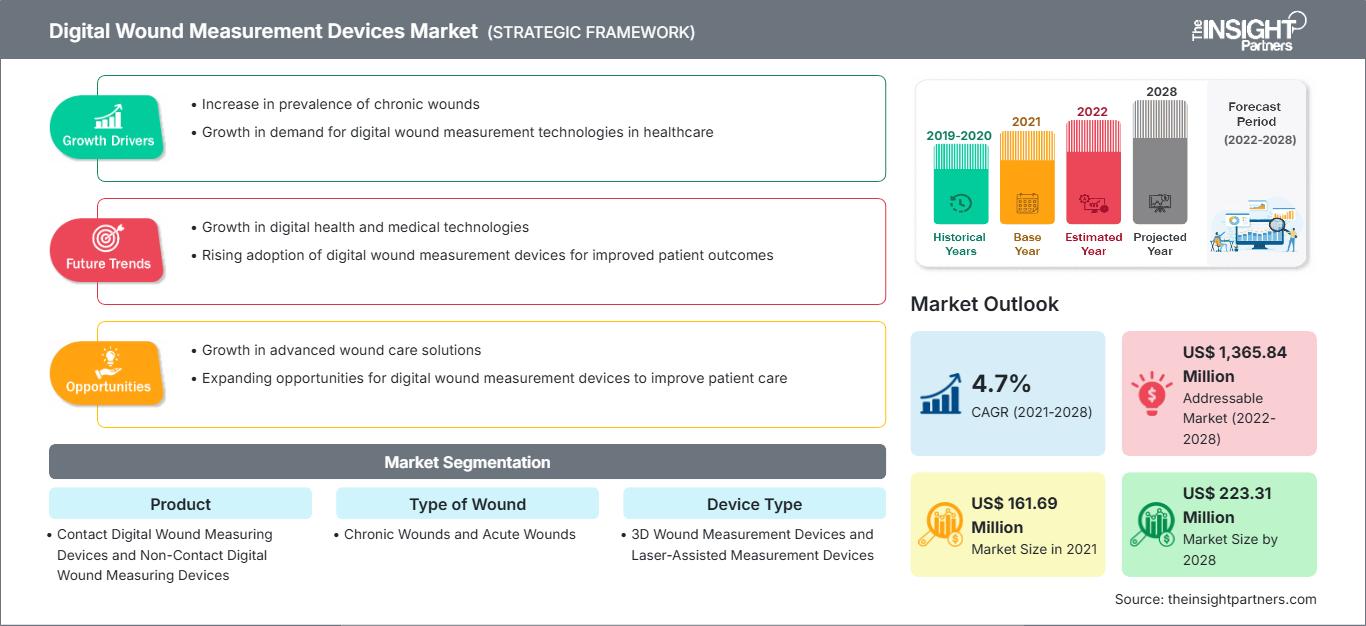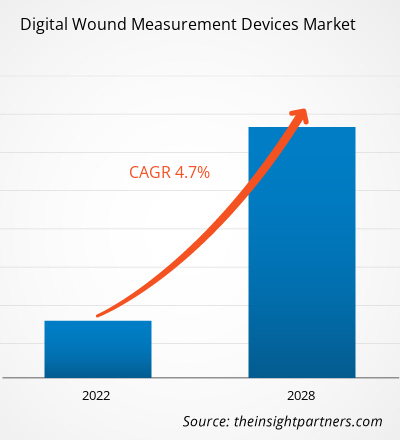[Rapporto di ricerca]Si prevede che il mercato dei dispositivi digitali per la misurazione delle ferite crescerà da 161,69 milioni di dollari nel 2021 a 223,31 milioni di dollari entro il 2028; si stima una crescita a un CAGR del 4,7% dal 2021 al 2028.
Il mercato dei dispositivi digitali per la misurazione delle ferite è segmentato in base a prodotto, tipo di ferita, applicazione, tipo di dispositivo, utente finale e area geografica. Per area geografica, il mercato dei dispositivi digitali per la misurazione delle ferite è ampiamente suddiviso in Nord America, Europa, Asia-Pacifico, Medio Oriente e Africa e America meridionale e centrale. Il rapporto offre approfondimenti approfonditi sul mercato, evidenziando parametri quali tendenze di mercato, progressi tecnologici e dinamiche di mercato, insieme all'analisi del panorama competitivo dei principali attori del mercato.
Personalizza questo rapporto in base alle tue esigenze
Potrai personalizzare gratuitamente qualsiasi rapporto, comprese parti di questo rapporto, o analisi a livello di paese, pacchetto dati Excel, oltre a usufruire di grandi offerte e sconti per start-up e università
Mercato dei dispositivi di misurazione digitale delle ferite: Approfondimenti strategici

-
Ottieni le principali tendenze chiave del mercato di questo rapporto.Questo campione GRATUITO includerà l'analisi dei dati, che vanno dalle tendenze di mercato alle stime e alle previsioni.
Approfondimenti di mercato
L'aumento dell'incidenza delle ulcere contribuisce in modo significativo alla crescita del mercato
La crescente adozione di stili di vita non sani, il consumo di alcol e il fumo contribuiscono all'aumento della prevalenza di malattie non trasmissibili. Ad esempio, nel 2018, l'Organizzazione Mondiale della Sanità (OMS) ha dichiarato che il 13% degli adulti di età pari o superiore a 18 anni era obeso a livello globale. Gli Stati Uniti presentano la più alta prevalenza di obesità (~42,4%), seguiti da Arabia Saudita, Turchia, Egitto, Libia, Iran, Iraq, Sudafrica, Canada, Messico, Australia e molti paesi sudamericani ed europei. Inoltre, il diabete colpiva 34,2 milioni di cittadini americani (il 10,5% della popolazione) nel 2018. Il prediabete colpisce 88 milioni di persone e, se non trattato, può evolvere in diabete di tipo 2 (T2D) entro cinque anni. Il diabete colpisce circa il 4,2% delle persone di età compresa tra 18 e 44 anni, circa il 17,5% degli adulti di età compresa tra 45 e 64 anni e circa il 26,8% di quelli di età pari o superiore a 65 anni. Pertanto, i crescenti rischi associati al diabete, come le ulcere del piede diabetico e le piaghe da decubito, stanno aumentando le dimensioni del mercato dei dispositivi digitali per la misurazione delle ferite. Inoltre, le complicanze associate al diabete, come le ulcere del piede diabetico (DFU), stanno anche facilitando la necessità di prodotti avanzati per la gestione delle ferite. Ad esempio, secondo l'International Diabetes Federation, le persone con diabete hanno una probabilità da 15 a 40 volte maggiore di dover ricorrere all'amputazione della parte inferiore della gamba. Circa l'85% delle amputazioni è seguito dallo sviluppo di un'ulcera neuropatica del piede. Pertanto, questi fattori stanno determinando la domanda di dispositivi digitali per la misurazione delle ferite nel periodo di previsione.
Approfondimenti basati sul prodotto
In base alla tipologia di prodotto, il mercato dei dispositivi digitali per la misurazione delle ferite si divide in dispositivi digitali per la misurazione delle ferite senza contatto e dispositivi digitali per la misurazione delle ferite a contatto. Nel 2021, il segmento dei dispositivi digitali per la misurazione delle ferite senza contatto ha rappresentato una quota di mercato maggiore grazie ai progressi tecnologici e al modo efficace e senza contatto del dispositivo di misurare la superficie e il volume delle ferite.
Approfondimenti basati sul tipo di ferita
In base al tipo di ferita, il mercato dei dispositivi digitali per la misurazione delle ferite si divide in ferite croniche e ferite acute. Le ferite croniche si dividono ulteriormente in ulcere da pressione (PU), ulcere del piede diabetico (DFU), ulcere venose degli arti inferiori (VLU) e ulcere arteriose. Le ferite acute si dividono ulteriormente in ustioni e Traumi e ferite chirurgiche. Il segmento delle ferite croniche ha detenuto una quota di mercato maggiore nel 2021. Ciò è attribuito all'aumento dell'incidenza di ferite croniche come ulcere da pressione, ulcere del piede diabetico, ulcere venose degli arti inferiori e ulcere arteriose.
Approfondimenti basati sul tipo di dispositivo
In base al tipo di dispositivo, il mercato dei dispositivi digitali per la misurazione delle ferite si divide in dispositivi per la misurazione 3D delle ferite e dispositivi per la misurazione laser assistita. Il segmento dei dispositivi per la misurazione laser assistita ha detenuto una quota di mercato maggiore nel 2021; si prevede che registrerà un CAGR più elevato nel mercato durante il periodo di previsione.
Approfondimenti basati sull'applicazione
In base all'applicazione, il mercato dei dispositivi digitali per la misurazione delle ferite è segmentato in cura delle ferite, conservazione degli arti e chirurgia ricostruttiva. Il segmento della cura delle ferite è ulteriormente segmentato in perfusione sanguigna, ossigenoterapia iperbarica, vitalità tissutale e altri. Il segmento delle ferite croniche ha detenuto la quota maggiore del mercato dei dispositivi digitali per la misurazione delle ferite nel 2021. Tuttavia, si prevede che il segmento della cura delle ferite registrerà il CAGR più elevato nel mercato dei dispositivi digitali per la misurazione delle ferite durante il periodo di previsione.
Informazioni basate sull'utente finale
In base all'utente finale, il mercato dei dispositivi digitali per la misurazione delle ferite è suddiviso in ospedali e cliniche e centri comunitari. Il segmento ospedali e cliniche ha detenuto una quota maggiore del mercato dei dispositivi digitali per la misurazione delle ferite nel 2021; si prevede che registrerà un CAGR più elevato nel mercato dei dispositivi digitali per la misurazione delle ferite durante il periodo di previsione.
Lanci di prodotti, fusioni e acquisizioni sono strategie ampiamente adottate dagli operatori globali del mercato dei dispositivi digitali per la misurazione delle ferite. Di seguito sono elencati alcuni dei recenti sviluppi chiave del mercato:
A settembre 2021, Kent Imaging ha annunciato l'approvazione di Health Canada per SnapshotNIR V3.0 (KD204), ora disponibile per la spedizione in entrambe le lingue ufficiali. Questo aggiornamento apporta significativi miglioramenti alle funzionalità della tecnologia di imaging, migliorando la valutazione dei tessuti nelle ferite acute e croniche.
Dispositivi digitali per la misurazione delle ferite: segmentazione del mercato
In base al prodotto, il mercato dei dispositivi digitali per la misurazione delle ferite si divide in dispositivi digitali per la misurazione delle ferite a contatto e dispositivi digitali per la misurazione delle ferite senza contatto. In base al tipo di ferita, il mercato si divide in ferite croniche e ferite acute. Il segmento delle ferite croniche è ulteriormente suddiviso in ulcere da pressione (PU), ulcere del piede diabetico (DFU), ulcere venose degli arti inferiori (VLU) e ulcere arteriose. Il segmento delle ferite acute è ulteriormente suddiviso in ustioni e traumi e ferite chirurgiche. In base alla tipologia di dispositivo, il mercato dei dispositivi digitali per la misurazione delle ferite si suddivide in dispositivi per la misurazione 3D delle ferite e dispositivi per la misurazione laser assistita. In base all'applicazione, il mercato dei dispositivi digitali per la misurazione delle ferite si suddivide in cura delle ferite, conservazione degli arti e chirurgia ricostruttiva. Il segmento della cura delle ferite si suddivide ulteriormente in perfusione sanguigna, ossigenoterapia iperbarica, vitalità tissutale e altri. In base all'utente finale, il mercato dei dispositivi digitali per la misurazione delle ferite si suddivide in ospedali, cliniche e centri comunitari. In base all'area geografica, il mercato è principalmente segmentato in Nord America, Europa, Asia-Pacifico, Medio Oriente e Africa, America meridionale e centrale.
Approfondimenti regionali sul mercato dei dispositivi di misurazione digitale delle ferite
Le tendenze regionali e i fattori che influenzano il mercato dei dispositivi digitali per la misurazione delle ferite durante il periodo di previsione sono stati ampiamente spiegati dagli analisti di The Insight Partners. Questa sezione illustra anche i segmenti e la geografia del mercato dei dispositivi digitali per la misurazione delle ferite in Nord America, Europa, Asia-Pacifico, Medio Oriente e Africa, America meridionale e centrale.
Ambito del rapporto di mercato sui dispositivi di misurazione digitale delle ferite
| Attributo del rapporto | Dettagli |
|---|---|
| Dimensioni del mercato in 2021 | US$ 161.69 Million |
| Dimensioni del mercato per 2028 | US$ 223.31 Million |
| CAGR globale (2021 - 2028) | 4.7% |
| Dati storici | 2019-2020 |
| Periodo di previsione | 2022-2028 |
| Segmenti coperti |
By Prodotto
|
| Regioni e paesi coperti |
Nord America
|
| Leader di mercato e profili aziendali chiave |
|
Densità degli operatori del mercato dei dispositivi di misurazione digitale delle ferite: comprendere il suo impatto sulle dinamiche aziendali
Il mercato dei dispositivi digitali per la misurazione delle ferite è in rapida crescita, trainato dalla crescente domanda degli utenti finali, dovuta a fattori quali l'evoluzione delle preferenze dei consumatori, i progressi tecnologici e una maggiore consapevolezza dei vantaggi del prodotto. Con l'aumento della domanda, le aziende stanno ampliando la propria offerta, innovando per soddisfare le esigenze dei consumatori e sfruttando le tendenze emergenti, alimentando ulteriormente la crescita del mercato.

- Ottieni il Mercato dei dispositivi di misurazione digitale delle ferite Panoramica dei principali attori chiave
Profili aziendali
- eKare Inc.
- Kent Imaging Inc.
- WoundMatrix Inc.
- Perceptive Solutions
- WoundVision
- Aranz Medical Ltd.
- Tissue Analytics
- Fuel 3D Technologies Ltd.
- Hitachi Aloka Medical America Inc.
- MolecuLight Inc.
- Analisi storica (2 anni), anno base, previsione (7 anni) con CAGR
- Analisi PEST e SWOT
- Valore/volume delle dimensioni del mercato - Globale, Regionale, Nazionale
- Industria e panorama competitivo
- Set di dati Excel
Report recenti
Rapporti correlati
Testimonianze
Motivo dell'acquisto
- Processo decisionale informato
- Comprensione delle dinamiche di mercato
- Analisi competitiva
- Analisi dei clienti
- Previsioni di mercato
- Mitigazione del rischio
- Pianificazione strategica
- Giustificazione degli investimenti
- Identificazione dei mercati emergenti
- Miglioramento delle strategie di marketing
- Aumento dell'efficienza operativa
- Allineamento alle tendenze normative






















 Ottieni un campione gratuito per - Mercato dei dispositivi di misurazione digitale delle ferite
Ottieni un campione gratuito per - Mercato dei dispositivi di misurazione digitale delle ferite